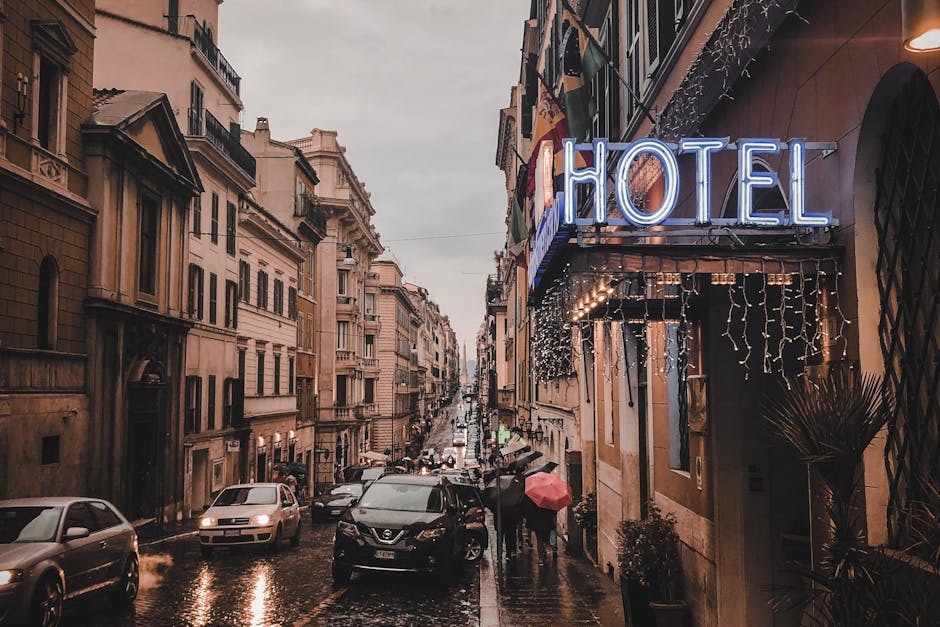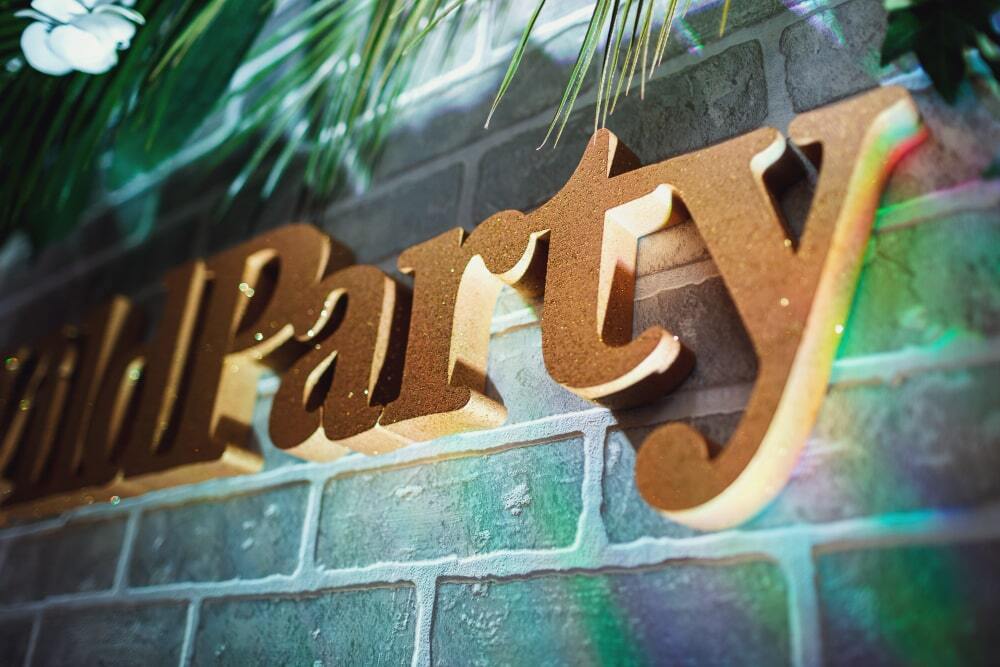Weatherproof outdoor signs installations are more than just applying a coat of paint. In order to guarantee long-term durability and appearance, each step from material choice to sealing and maintenance must be handled with precision. In this guide, I’ll walk you through the technical and practical best practices for ensuring your signage withstands sun, rain, wind, and temperature extremes. To learn more about whether weatherproof outdoor signs are the right choice for your business, check out our blog “Pros and Cons of Having Weatherproof Outdoor Signs,” where we break down the key benefits and
Why weatherproof Matters for 3D Letters in Outdoor Signs
Outdoor signs are constantly exposed to environmental stress: UV rays, wind-blown debris, rain, frost, and pollution. Without having proper weatherproof outdoor sign boards, even the most striking weatherproof outdoor signs designs will degrade quickly—leading to faded colours, rust, warping, or even detachment from the substrate.
Brand Reputation and Visual Impact
Your outdoor sign is often the first point of contact between your business and potential customers. Cracked, faded, or stained 3D letters for wall project neglect and poor quality. On the flip side, crisp, clean, and sharp signage communicates professionalism and attention to detail. Long-term visual consistency reinforces brand identity.
Cost Implications of Poor weatherproof
Neglecting weatherproofs can cost more in the long run. Frequent repairs, replacements, or touch-ups eat into budgets. Investing upfront in effective weatherproof methods for weatherproof outdoor signs applications is far more economical than reacting to failures later.
Safety and Compliance Concerns
Outdoor signs that aren’t structurally secured or suffer from corrosion may pose a safety risk. Falling letters or sharp edges can create liability issues. Proper sealing, fastening, and maintenance prevent such risks and ensure compliance with local signage regulations.
Choosing the Right Materials for 3D Letters in Outdoor Signs
Material choice is the foundation of any durable outdoor sign. The lifespan, maintenance needs, and visual appeal of your weatherproof outdoor signs are directly tied to what they’re made from. Here’s a breakdown of the most reliable materials used in the industry, along with their pros, cons, and best-use scenarios.
1. Acrylic Letters (PMMA)
Why it works: Acrylic is weather-resistant, UV-stable, and doesn’t yellow or become brittle easily. It offers a clean, polished look with high visual clarity.
Pros:
- Excellent resistance to UV and moisture
- Lightweight and easy to mount
- Available in a variety of colours and finishes
- Can be backlit or face-lit
Cons:
- May crack under strong impact
- Requires proper sealing around edges to prevent water ingress
Best for: Retail signage, corporate offices, and hospitality venues.
2. Aluminium Letters
Why it works: Aluminium is rust-proof, lightweight, and exceptionally durable. It doesn’t corrode like steel and holds finishes very well.
Pros:
- Naturally weather-resistant
- Can be powder-coated for added protection
- Works well in coastal or high-humidity areas
- Recyclable and eco-friendly
Cons:
- Slightly higher initial cost
- Requires periodic cleaning to avoid dulling
Best for: Industrial buildings, business parks, and signage exposed to high winds or salt air.
3. Stainless Steel Letters
Why it works: Offers premium aesthetic appeal with high resistance to corrosion and weathering, especially in harsher environments.
Pros:
- Strong and tamper-resistant
- Ideal for a brushed or mirrored finish
- Excellent longevity
Cons:
- Heavier and more expensive than other options
- Needs precise mounting to handle weight
Best for: Corporate headquarters, banks, and architectural signage.
4. PVC or Foam Letters (with Coating)
Why it works: Lightweight and cost-effective. When properly coated, they resist UV damage and moisture.
Pros:
- Easy to install on most substrates
- Affordable for short- to mid-term use
- Can be painted or vinyl-wrapped
Cons:
- Prone to deformation under heat
- Needs edge-sealing to prevent water ingress
Best for: Temporary displays, exhibitions, or lower-budget applications with limited exposure.
5. Composite Materials (e.g., Dibond)
Why it works: Combines aluminium and a solid plastic core for added stability. Highly weather-resistant and used in demanding environments.
Pros:
- Rigid and strong while still lightweight
- Excellent panel stability
- Long lifespan with minimal upkeep
Cons:
- Limited options for shaping complex 3D contours
Best for: Sign trays, large outdoor panels, and modern facades.
Sealing and Protective Coatings for 3D Letters: Guarding Against the Elements
Choosing high-quality materials is just the first step. Sealing and coating are what truly make your weatherproof outdoor signs resilient against rain, sunlight, grime, and pollutants. This section outlines the essential techniques and products used to create an impermeable, long-lasting barrier around your signage.
The Purpose of Sealing and Coating
Without proper sealing:
- Water can seep into cracks or behind lettering, causing swelling, delamination, or rot (in foam/PVC-based products).
- UV rays will bleach pigments, causing uneven fading or yellowing.
- Airborne debris can embed into porous surfaces, accelerating deterioration.
An effective sealing strategy reduces wear, maintains appearance, and lowers your maintenance burden.
1. Clear Polyurethane Coating
What it does: Forms a transparent shield over the letter surface, protecting against moisture, dust, and UV rays.
Best used on: Acrylic, PVC, and painted surfaces.
Benefits:
- Adds gloss and vibrancy
- Enhances UV protection
- Available in matte, satin, and high-gloss finishes
Application Tip: Apply at least two coats, with proper drying time between layers, in a clean, dust-free environment.
2. Powder Coating (for Metal Letters)
What it does: Powder coating is an electrostatically applied dry finish that is baked onto the surface. It creates a durable, weatherproof layer.
Best used on: Aluminium and stainless steel letters.
Benefits:
- Extremely resistant to chipping, scratching, and fading
- Available in custom colours and textures
- Zero VOCs (eco-friendly option)
Application Tip: Ensure proper surface preparation—clean, sanded, and free of contaminants—for full adhesion.
3. Silicone Edge Sealing
What it does: Seals the joints and edges of letters to prevent water ingress behind the sign face.
Best used on: PVC foam, acrylic, and layered substrates.
Benefits:
- Flexible under temperature fluctuations
- Transparent options won’t interfere with appearance
- Essential for longevity in wet climates
Application Tip: Use neutral cure silicone to avoid corrosion on metal elements.
4. Anti-Graffiti and Anti-Dust Coatings
What it does: These specialty coatings repel dirt, oil, and spray paint, making it easier to clean and maintain signage.
Best used on: High-traffic areas and urban environments.
Benefits:
- Long-term ease of maintenance
- Preserves brand presentation in public-facing spaces
Application Tip: Choose a product designed specifically for sign use to prevent hazing or discolouration.
5. UV Laminates (for Vinyl or Printed Surfaces)
What it does: Laminates are applied over digital prints or vinyl wraps to extend their outdoor durability.
Best used on: 3D Printed letters or background panels.
Benefits:
- Shields against fading and cracking
- Can enhance surface gloss or add texture
Installation Techniques for Maximum Weather Resistance

Even the most weatherproof materials and coatings won’t hold up if the weatherproof outdoor signs are installed poorly. The mounting method determines how well the letters handle wind load, temperature shifts, moisture seepage, and daily wear. In this section, we’ll break down proven installation practices that ensure long-term durability and minimal maintenance.
1. Use of Stand-Offs and Spacers
What they are: Stand-offs are small spacers mounted between the letter and the wall surface, allowing air to circulate behind the letters.
Why they matter:
- Prevent water pooling behind the letters
- Reduce thermal stress by allowing expansion and contraction
- Add depth and visual appeal
Best practice: Use non-corrosive metal or UV-stable plastic spacers. Always seal anchor points with silicone to block moisture ingress.
2. Proper Wall Preparation
Before installation:
- Clean the wall surface thoroughly to remove dust, oils, and residues
- Ensure the mounting area is flat and dry
- Prime porous materials (like brick or concrete) to increase adhesion and reduce moisture absorption
Benefits:
- Improves bonding and alignment
- Prevents water penetration through unsealed wall surfaces
- Reduces risk of letter loosening over time
3. Mechanical Fixings with Weather Seals
What it involves: Combining screws, pins, or bolts with gaskets and silicone sealant to create watertight fixing points.
Why it’s critical:
- Mechanical fixing ensures strong retention under wind load
- Sealants prevent water entering holes and causing rust or substrate damage
Best practice: Use stainless steel or galvanised fixings. Avoid low-grade steel, which will corrode quickly in rain or salt air.
4. Adhesive Bonding for Smooth Surfaces
When to use it: On glass, metal cladding, or polished stone where drilling is not possible or desirable.
Recommended adhesives:
- High-performance polyurethane or epoxy adhesives
- UV-resistant construction adhesives designed for exterior signage
Best practice: Apply pressure during curing to ensure uniform contact. Clean surfaces with alcohol-based solution before bonding.
5. Drainage Considerations
Why it matters: Water trapped behind 3D letters can freeze, causing expansion and cracking. It can also foster mould or moss growth.
How to prevent it:
- Install drainage holes where needed (especially in hollow or channel letters)
- Use open-back letter designs on ventilated surfaces
- Ensure spacing between letters and wall allows runoff and airflow
6. Thermal Expansion Allowance
What to plan for: Outdoor signage boards are exposed to wide temperature swings. Materials like acrylic or PVC expand and contract.
Best practice: Leave slight tolerance gaps between panels or fixings, and avoid rigid bonding. Flexible adhesives or floating mounts allow controlled movement without cracking or warping.
Maintenance and Cleaning Best Practices for Outdoor 3D Letters
Even the most durable weatherproof outdoor signs need upkeep to retain their sharp appearance and functionality. weatherproof protects the structure, but dirt, debris, pollution, and UV exposure can still take a toll over time. Regular maintenance ensures your signage continues to reflect your brand in the best light.
1. Set a Maintenance Schedule
Why it’s important: Preventative maintenance is far more effective (and cheaper) than reactive repairs. Sticking to a regular schedule reduces wear and flags potential issues early.
Suggested frequency:
- Visual inspection: Every 3 months
- Surface cleaning: Every 6 months
- Sealant/fastener check: Annually
- Re-coating (if applicable): Every 2–3 years, or as needed
2. Cleaning Methods by Material Type
Acrylic Letters:
- Use a mild detergent and warm water with a soft cloth.
- Avoid alcohol, ammonia, or solvent-based cleaners—these can cause crazing (fine surface cracks).
- Buff with a microfibre cloth to restore clarity.
Aluminium & Stainless Steel Letters:
- Wipe with a non-abrasive sponge and diluted soap solution.
- Use a stainless-steel polish or metal cleaner to remove fingerprints or water spots.
- Avoid wire brushes or scouring pads that may scratch protective coatings.
PVC or Foam Letters (with coating):
- Use lukewarm water and a soft sponge.
- Never pressure-wash, as this can compromise edges or coatings.
- Rinse thoroughly and dry to prevent streaking or spotting.
3. Inspect Fixings and Seals
Why it matters: Movement in fixings, loosening of sealant, or cracking around edges can invite moisture in, which undermines the entire weatherproof effort.
Checklist:
- Check all screws, bolts, and spacers for rust or wobble
- Look for peeling sealant or gaps between the letter and wall
- Test adhesion in glued areas with gentle pressure
- Examine for hidden mould or staining behind letters (especially in humid zones)
4. Reapply Protective Coatings When Necessary
What to look for:
- Faded colours or a chalky residue on the surface (sign of UV degradation)
- Peeling or flaking of existing clear coats
- Dull or patchy gloss levels
How to reapply:
- Lightly sand the surface to create grip
- Clean thoroughly with isopropyl alcohol or similar prep cleaner
- Apply new UV clear coat or polyurethane in thin, even layers
Pro tip: Recoating on a warm, dry day ensures proper curing and avoids moisture entrapment.
5. Winterising Your Outdoor Signage
In colder climates:
- Avoid de-icing chemicals around your signage base—they can corrode metals and stain plastics.
- Clear snow accumulation around wall fixtures to reduce cold soak and thermal cracking.
- Schedule sealant and fixings inspection just before winter begins.
6. Graffiti and Stain Removal
If your signage is targeted:
- Use dedicated anti-graffiti coatings during fabrication to simplify removal.
- Avoid acetone or strong solvents unless verified safe for your specific sign materials.
- Use graffiti wipes or citrus-based removers on painted or coated metal.
Frequently Asked Questions
1. What is the best material for weatherproof outdoor signs use in harsh weather?
The best material depends on the specific environmental challenges. Aluminium is widely regarded as one of the most durable choices for weatherproof outdoor signs, especially in coastal or industrial areas due to its rust resistance. Acrylic is excellent for UV exposure and aesthetic consistency. Stainless steel offers premium strength and finish, but it’s heavier and costlier. For budget-conscious projects, coated PVC foam letters can work if properly sealed.
2. How can I prevent my weatherproof outdoor signs from fading over time?
Fading is caused by UV exposure. To prevent this:
- Choose UV-stable materials like cast acrylic.
- Apply a UV-resistant clear coat.
- Opt for powder-coated metal letters rather than painted options.
- Regularly clean your weatherproof outdoor signs to remove pollutants that accelerate fading.
3. Are weatherproof outdoor signs waterproof by default?
No, not all weatherproof outdoor signs are waterproof by default. Even durable materials can fail if the installation is not sealed correctly. Waterproofing depends on:
- The material used
- Proper edge sealing
- The mounting technique
- Protective coatings applied
Sealing joints, using high-quality fixings, and applying a polyurethane or powder coating are all critical.
4. How often should I inspect and maintain my weatherproof outdoor signs?
A standard maintenance plan should include:
- Visual inspections every 3 months
- Cleaning every 6 months
- Fixing and sealant checks once a year
- Re-coating every 2–3 years (depending on exposure)
For weatherproof outdoor signs in high-traffic or extreme-weather areas, inspect more frequently to catch issues early.
5. Can I install weatherproof outdoor signs on uneven or textured surfaces like brick?
Yes, but additional care is required. On brick or stone, you should:
- Use stand-offs to provide a flush, even mounting surface
- Seal all fixings with outdoor-grade silicone
- Avoid direct bonding unless the surface is primed and treated
Proper spacing and mounting methods help your weatherproof outdoor signs stay secure and weatherproof over time.
6. What’s the difference between using adhesives and mechanical fixings for weatherproof outdoor signs?
Adhesives are cleaner and faster but only work reliably on smooth, sealed surfaces (glass, metal, polished concrete). Mechanical fixings offer stronger anchorage, especially for heavy materials like metal or when installing on textured substrates. For high-wind or high-moisture areas, mechanical fixings with sealing gaskets are the preferred method for long-term performance of weatherproof outdoor signs.
7. Are illuminated weatherproof outdoor signs more vulnerable to weather damage?
Illuminated weatherproof outdoor signs require added protection:
- Use IP-rated (Ingress Protection) LEDs and transformers
- Ensure all wiring is insulated and housed in weather-sealed casings
- Apply moisture barriers and drainage channels if needed
Professional-grade illumination systems are designed with outdoor durability in mind, but they must still be installed and maintained correctly to avoid short-circuits or moisture build-up.
8. Can I repaint my existing weatherproof outdoor signs?
Yes, repainting is possible, but it must be done properly:
- Clean and sand the surface to remove old finishes
- Use a primer suitable for the substrate
- Apply UV-stable outdoor paint
- Seal with a clear protective top coat
Repainting gives a fresh look and extends the life of your weatherproof outdoor signs, especially if fading or staining has begun.
9. Do weatherproof outdoor signs require special treatment in coastal areas?
Absolutely. Coastal environments introduce salt, which accelerates corrosion. For signs near the sea:
- Use marine-grade stainless steel or aluminium
- Apply anti-corrosive coatings
- Schedule more frequent cleaning to remove salt deposits
- Avoid uncoated metals or untreated fixings
These steps are crucial for the longevity of weatherproof outdoor signs in seaside locations.
10. What is the typical lifespan of properly weatherproofed weatherproof outdoor signs?
With quality materials, correct installation, and consistent maintenance, the average lifespan of weatherproofed weatherproof outdoor signs ranges from:
- 5–7 years for painted PVC or foam (with regular re-coating)
- 10–15 years for acrylic or composite letters
- 15–20+ years for powder-coated aluminium or stainless steel
Investing in weatherproof from the start ensures the sign remains visually strong and structurally sound over the long haul.
Ready to Upgrade Your Outdoor Signage?
At Misgns, we specialise in crafting high-performance, weatherproof weatherproof outdoor signs solutions tailored to your brand and built for the elements. Whether you’re starting from scratch or upgrading existing signage, our expert team is here to ensure your signs look sharp, stay secure, and last for years.

















